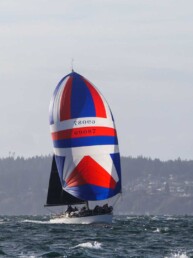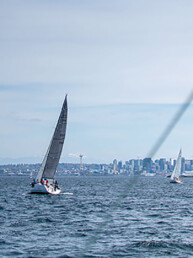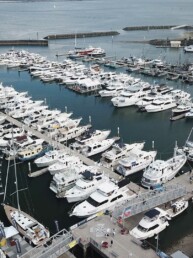Check back here for running updates and analysis of R2AK 2022…
After a two year hiatus, R2AK 2022 was a wild and epic voyage…
When Team Fix oder Nix and Team Sockeye Voyages rang the finishing bell in Ketchikan on Thursday evening July 7, so closed another chapter in what has become an incredible race of human endurance and adventure.
The gale force first leg from Port Townsend to Victoria was a true “proving ground.” The log dodging antics on the Inside Passage was not only difficult but disappointing for racers. The beat up the west side of Vancouver for the three teams who chose to go out side was no cakewalk. And, when teams made it to the race’s only waypoint at Bella Bella, it was with a mix of weather, emotions, and decisions. From there, Alaska was still a ways off and whether they chose Hecate Strait or more protected waters on the inside, watching each team fight for the finish was awe-inspiring.
As someone who has finished this race before, I know the fight well and can honestly give a huge and hearty congratulations and job well done to everyone who pushed their chips into the middle and went for it. It’s all perfectly summed up here…
“Emotions run wild.
– I feel BIG
– I’ve never been a better problem solver
– I’ve lost most of my skin on my hands
– I’m never eating oatmeal again
– I want to continue sailing forever
Thank you to everyone who made this real for me. We are all better for it.”
Tara, Team Sockeye Voyages
Teams Sockeye Voyages and Fix oder Nix have crossed the border and are heading for the finish line.
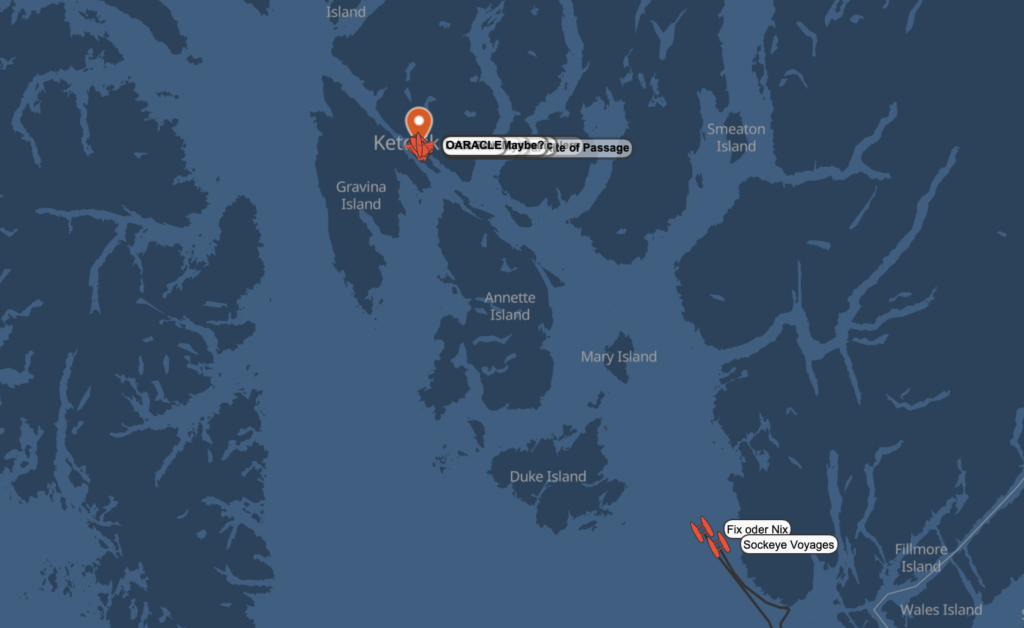 I have to say, one of my favorite parts of following the R2AK isn’t just seeing how it plays out at the front, but following the teams bringing up the rear who are full of grit and determination to see this thing through to the end. As of noon on July 7, Sockeye Voyages and Fix oder Nix are doing just that. My hat is off to them, I’ll be glued to the live feed when they reach the dock.
I have to say, one of my favorite parts of following the R2AK isn’t just seeing how it plays out at the front, but following the teams bringing up the rear who are full of grit and determination to see this thing through to the end. As of noon on July 7, Sockeye Voyages and Fix oder Nix are doing just that. My hat is off to them, I’ll be glued to the live feed when they reach the dock.
Here’s the latest Race Boss Report:
Day 20: Playing through Loss Aversion
Fix Oder Nix and Sockeye Voyages. Two teams who know this race differently than any others. At 20 days they are the only ones left on the field, with the Grim Sweeper at Rennison Island by noon today. The best communication only gives up snippets, like puzzle pieces, to assemble their experiences into complete pictures.
“Crew tired”
“Going on”
But today, we will take the uncharacteristic path of not rearranging a few words into paragraphs of extemporized possibility. We are going to tell it like it is because failure is a word on our mind. (Abuse the word failure, and it gets bad results. It requires some context and definition.) The term will be used by teams who raced this year, teams who exited days ago, or even as far back as the Proving Ground. Others will have made it all the way to Ketchikan and still feel an emptiness, unsatisfied with their result. What’s often on the scorecard has little to do with expectation, and failure is deeply personal. Consider this a panegyric for all teams who choose what goalpost to aim for and decide if they made their mark.
Whether you finish in Ketchikan, Bella Bella, Campbell River, or Dungeness Spit, Race to Alaska has goals and you reach them or you don’t. In discussing it, we came up with nothing better than we’ve said before and so are offering up a cut from 2016…Keep reading
The First Human Powered Team has Finished!
HUGE congratulations to Team Don’t Tell Mom, who finished at 7:03 AM AKST!!!
 Day 14: Falling titans, toes for math, and the Grim Sweeper
Day 14: Falling titans, toes for math, and the Grim Sweeper
Featured image of Team Seas the Day by Julian Laffin.
Here’s the latest from the Race Boss:
Seven teams are on the playfield as opposed to five in 2019 at the same juncture, and two teams found their way to done yesterday, in two different ways.
Team Seas the Day (still not totally happy about puns for team names) sailed into Ketchikan in 14th place to an audience electronically bolstered by a family Zoom call of 8+ people and 70+ viewers on Facebook. What was their newfound advice imparted to the airwaves, you ask? “It doesn’t matter how much you prepare; you will never be prepared.”
Lillian of Team Interstice finished her race in the arguably more complex but other acceptable option. In a single text from Bella Bella, “Sorry friend; my heart of hearts says, go home,” she created her own finish line. For years, Lillian had been throwing herself against any challenge we conjure, completing R2AK in 2019, WA360 in 2021, and every single year of our human-powered race, SEVENTY48 (though she was disqualified in 2019 for leaving the race early to go to an R2AK party).
Field Reporter Lynnette Oostmeyer tagged along with Lillian for a few days in Bella Bella. Her piece is included below and gives a glimpse into why stopping before Ketchikan became the most important decision Lillian could make…Keep reading
Step aboard with 3rd place finishers Team Fashionably Late…
Go Teams Go!
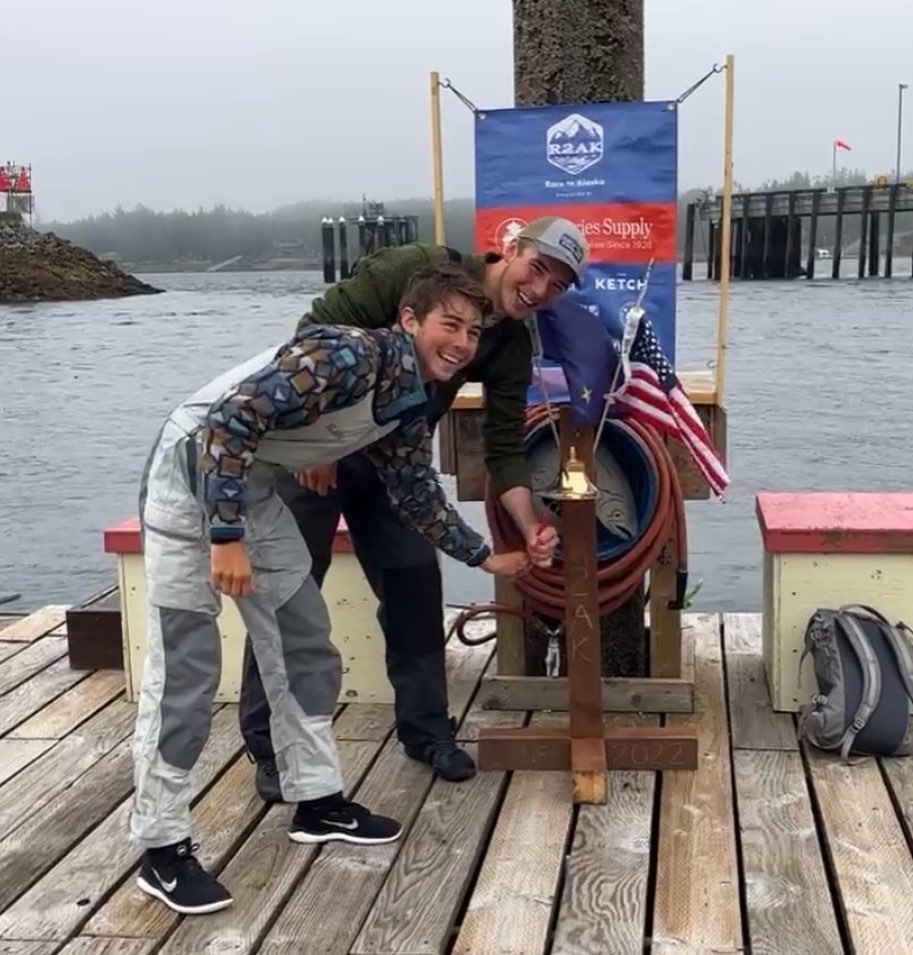
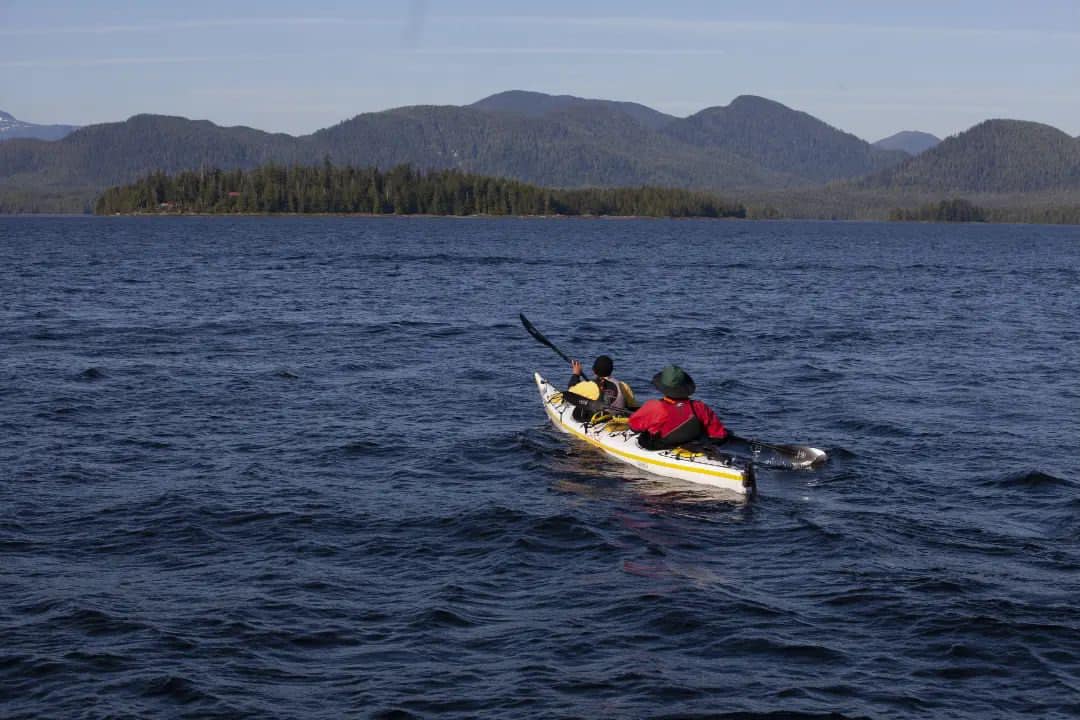
From our count there are nine teams left in this year’s R2AK. It looks like Team Goldfinch is going to be the next finisher and then after that we have a line of mostly human powered teams stretching from the top of Vancouver Island northward. This is the point in the race where my respect meter gets turned WAAAY up for those fighting for every mile. Having finished the race before, I know how hard it is on a 27 foot sailboat, but on a kayak or rower-cruiser? Damn, these teams are working hard.
Also, if you were curious about the galley setup for Team Rite of Passage, here ya go:
Team Rite of Passage edges out Team Wraith…
A huge shoutout goes to Mustang Survival’s Team Rite of Passage, the youngest team to every finish the Race to Alaska. They rang the bell in the wee hours of June 25, just eating out Team Wraith in the final miles. They enjoyed ice cold sodas in celebration!
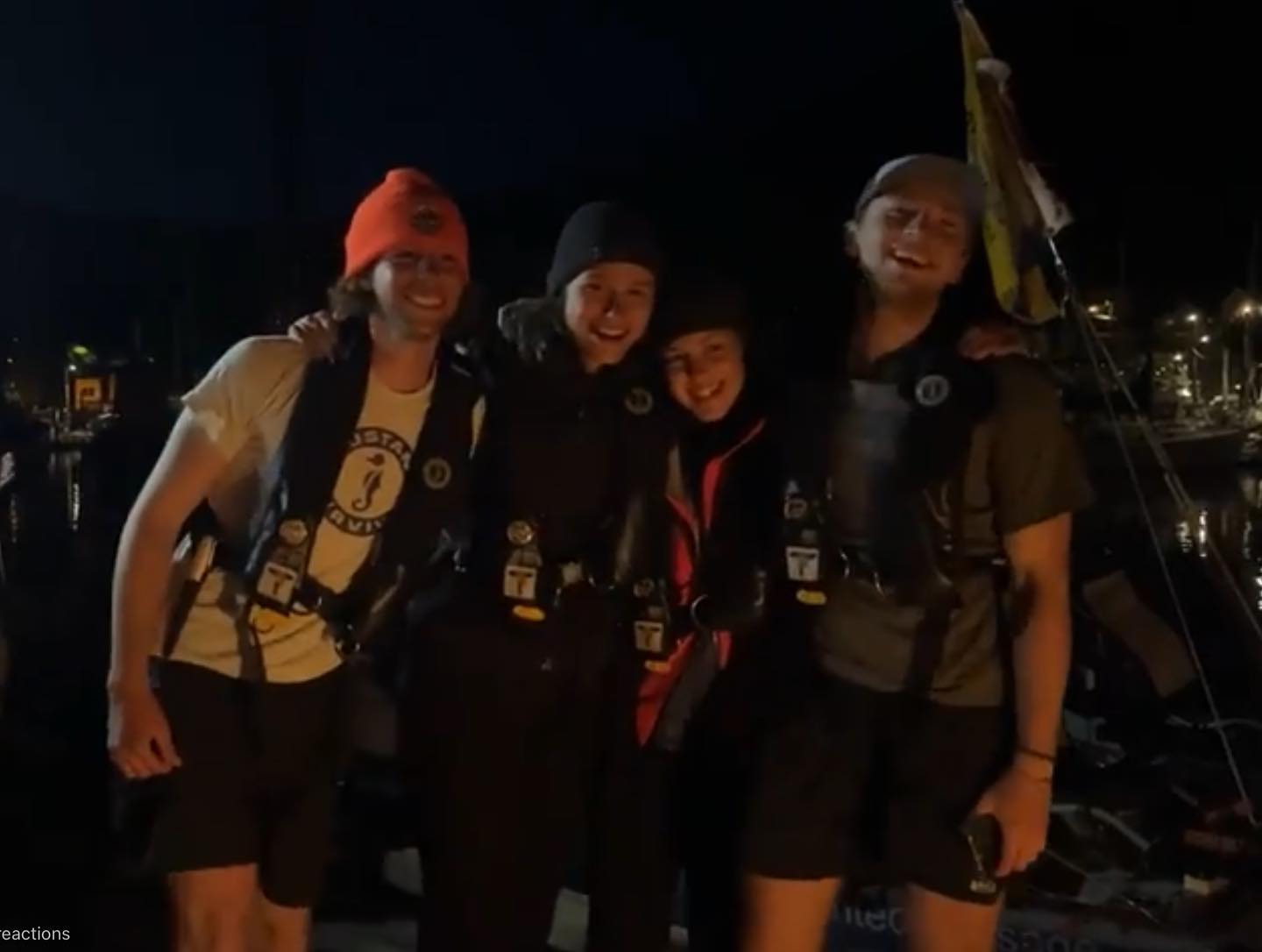
Here’s an update from the Race Boss:
Day 9: Moon shots, time-traveling, and a human named Odin
Day 9 in Ketchikan—with mercury high-fiving the 70º mark—started seeing the R2AK reunion in full swing with ten teams now in, two of them late/early enough today to find themselves wrangled into the total. Mere miles from the finish line, Team Wraith 2AK pulled a surprising upset by out-slowing Mustang Survival’s Team Rite of Passage to win the coveted 10th place award—though they were still not fast/slow enough to unseat the 2019 record-holder, High Seas Drifters, who came in 10th at 5d 9h 20m. However, we have moved solidly into digression and will talk more about today, tomorrow.
All that is to say, many teams are in, and the finish line is swelling with fans, racers turned fans, family who were always fans, and the random Ketchikan visitors who stroll down to the docks because of the hoopla and become fans. Eventually, every team wanders from elation to reeling through the past days or weeks in interactive, ad hoc storytelling. Off-camera, racer-on-racer conversations share intimate moments along the course in a type of confession that can only be witnessed by those who have shared in the experiment. Team Kootenay Pedalwheelers went west coast wide, and as much as Roger never regretted it, he missed the camaraderie of the Inside Passage. “We took a beating outside, and I can’t say we did much sailing that was fun. It’s wilderness out there, empty and cool, but we missed the match racing, the other teams… Keep reading
Another day in the R2AK and more finishers will be coming in.
Team Kootenay Pedalwheelers, pictured above ringing the bell, finished yesterday (June 23) and as of 6:50 a.m. Friday, High Seas Drifters, Wraith and Hardship are working their way north into the last stages the race.
I’d be remiss to say here how much I admire all the teams fighting hard at the back of the fleet. I have so much respect for them and how they choose to R2AK.
We got this report on Team Zen Dog and wish him well. The damage done to Team Zen Dog’s hands ended up being too much to overcome, and he decided early this morning to pull out of the race. Bob said he had a nice time paddling along with Lillian the last few days, and definitely found a friend in all this, but his injuries were just too significant to carry on. A family staying at the Lagoon Cove Marina offered to take him on their boat to Port Hardy, where he should be able to seek medical attention for his hands. He’s been a tracker fanatic since the start of the race in 2015, but he doesn’t think he’ll try to compete in it again. “It’s one hell of a race,” Bob said. “I’ll still always love it, but I’ve scratched that itch and can now move on.”
Also, here’s the word from Doug on Team Dark Star:
A flurry of finishers rang the bell in Ketchikan on Wednesday and into Thursday morning.
As expected, Team Elsewhere claimed the second place steak knives followed by teams Fashionably Late, Vegemite Vigilantes and Lost But Don’t Care! Congratulations to all. Apparently, the wind went light and the adverse current turned on to make it a slog to the finish. As Team Fashionably Late put it, “New respect gained for human powered vessels as the Race Boss turns on adverse currents in Tongass Narrows on the final approach.”
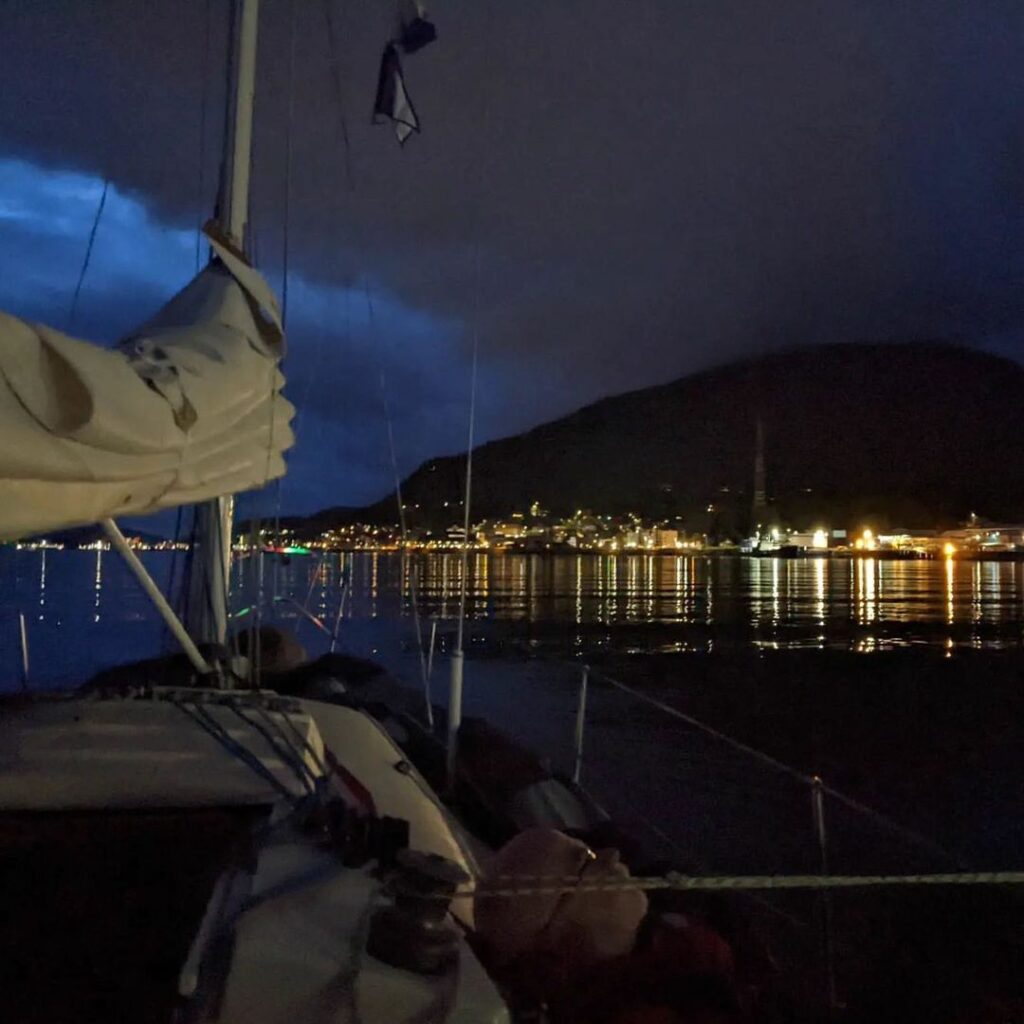
The coveted second place steak knives are up for grabs and it seems that Team Elsewhere is about to be somewhere…the finish.
A slew of teams are currently charging hard towards the boarder and it’s looking likely that several boats will right the bell today. In the back of the fleet, the human powered teams are stacked up in Johnstone Strait and they might be there for a while, as heavy winds are expected. Stay tuned to the tracker folks, there’s lots more R2AK to come.

Team Pure & Wild wins R2AK 2022!
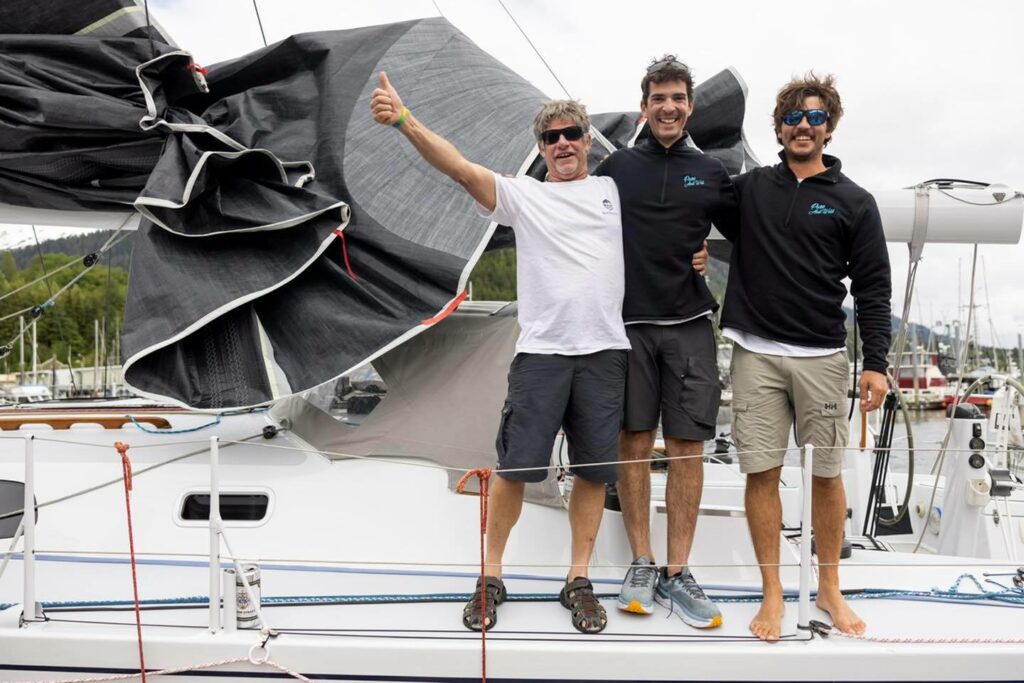 Sailing fast under full mainsail, staysail and asymmetrical spinnaker, Team Pure & Wild pushed toward the finish line in the late afternoon on Monday, June 20 with breaks of blue sky overhead. Just a few miles to the northwest in Ketchikan, Alaska, a bell was waiting to be rung, the 10 grand prize to be claimed and celebratory beers to be guzzled. Race to Alaska glory was theirs.
Sailing fast under full mainsail, staysail and asymmetrical spinnaker, Team Pure & Wild pushed toward the finish line in the late afternoon on Monday, June 20 with breaks of blue sky overhead. Just a few miles to the northwest in Ketchikan, Alaska, a bell was waiting to be rung, the 10 grand prize to be claimed and celebratory beers to be guzzled. Race to Alaska glory was theirs.
The scene was captured on video by an R2AK media team in a chase boat and the song they chose to set that marvelous moment to on Instagram? Immigrant Song by Led Zeppelin. The volume on my phone was on high when the iconic drums of John Bohnam burst through, leading into Robert Plant’s unmistakable opening, “Ah-ahhh, ah! Ah-ahhh, ah!” It was audio-visual perfection. Man, I felt like I was there.
There’s nothing quite like that feeling of sailing across the border at Dixon Entrance and into the channels leading to Ketchikan. But for everyone who throws their hat into the R2AK ring, the experience is different. Heck, for any team to make it to this point takes a seemingly herculean effort. But to win the whole shabang takes a distinctive combination of factors: You need a fast boat. That boat needs to be sailed with exceptional skill, prudent seamanship and smart decision making. And—possibly most importantly—you need a heavy dose of good fortune to see you through to the end.
Racing for SeaShare (seahare.org), a nonprofit that works with the U.S. seafood industry to distribute seafood to food banks nationwide, Team Pure & Wild combined the talents of sailors Jonathan McKee, Matt Pistay, and Alyosha Strum-Palerm. The boat? McKee’s Paul Bieker-designed Riptide 44 rocketship, dubbed Dark Star. The good fortune?
It’s been said in ocean sailing that luck favors the prepared, but in this version of R2AK, with literal rafts of logs plaguing teams at every tack and turn, it might not have mattered how prepared you were. Yet, part of Team Pure & Wild’s preparation was to make a crucial decision that aided in their victory—they rolled the dice and went outside into the Pacific Ocean.
“We knew there would be more wind out in the ocean,” Jonathan Mckee told me by phone, which data appeared to back up. “When we looked at the historical data prior to the race, the routing software told us that essentially 90% of the time it pays to go outside.”
While teams on the inside were dodging logs, plowing into them or leaping off waves on top of them, Team Pure & Wild shook off a slow start out of the Strait of Juan de Fuca before making the most of a northwesterly breeze when it finally filled in.
“The first 7 hours were tough because we had adverse current and not much wind. We expected to be pretty far behind compared to the inside boats after the first few hours. The question onboard was, ‘Can we make it up?’” Mckee said.
By all accounts, beating up the west coast of Vancouver Island is no picnic, but the Riptide 44 with those three sailors aboard was probably the boat and team best suited to take that challenge head on and come out on top.
Having completed the R2AK in 2018 as part of Team Wild Card and also cruised and raced on the west coast of Vancouver Island, I watched the tracker not only with excitement, but with a knowing perspective. And when I asked about the wind and sea state on the outside, it was pretty much what I expected. McKee added, “We had some pretty rough conditions about 50 to 100 miles south of the Brooks Peninsula. One of our team members wasn’t feeling well; we were essentially racing doublehanded for a while. It wasn’t easy.”
The next challenge was to get around the infamous Cape Scott. I speculated in past R2AK musings that, if an outside team could get to the top of the Vancouver Island and through the notoriously weird wind and currents at Cape Scott, there was a solid chance they’d be homefree reaching to Bella Bella and then running for Ketchikan. Some form of that came to fruition—and it was quite entertaining to follow.
McKee confirmed as much, “Nearing Cape Scott, we had 10 knots of breeze and things were pretty cruisy. Right when we got there, though, the wind died and the current was ripping against us and we struggled for about an hour to make it through to the new wind. Once we did, we had a nice night jib reaching to Bella Bella—the second half with the spinnaker.”
With my eyes alternating between computer screen and phone, this was about the point where I knew these guys would take it. Beyond the factors of boat and team, I mostly believed this would be true because in analyzing the weather on Hecate Strait for the days ahead, it appeared they’d have the most pressure and the least amount of land standing in their way. At that point, several top teams on the inside had, sadly, bowed out, and the closest teams were many miles behind.
After Bella Bella, the wind came up out of the south and southeast and Team Pure & Wild made a huge chunk of miles towards Ketchikan that night. “We reached out into Hecate Strait with the Code Zero and then put up the kite when we were able to fall off a bit.” McKee explained. “Then the wind increased to 25 knots during the night and the seas were pretty sporty for a while with big waves. We even had a high impact collision with a log…with no damage.”
Nearing the border in Dixon Entrance, the winds went light and their progress slowed, he remembered. “The sea state here was bad, not much breeze with waves coming from the west and south. Finally, we got some southerly wind and had a fantastic sail to the finish.”
Team Pure & Wild’s win was a feat that was not only fun to follow, but embodied the spirit of what the Race to Alaska is personally and as a community of racers.
In McKee’s words, “It wasn’t just about the race itself. We were in it to have some of those transcendent experiences that you can only have at sea. And we did. We came away with respect for the beauty and power of the ocean, which is only reinforced when you’re out there doing it, living it. Also, it was really cool to take part in an event that brings so many boating cultures together—the rowing, sailing, adventure communities. We have so much respect for the people on all the other boats.”
Indeed, I think we all do. Congratulations to Team Pure & Wild on an excellent race. Or, in the illustrious words of Robert Plant, “Ah-ahhh, ah! Ah-ahhh, ah!”
As with every version of the R2AK, multiple races end up playing out within the race…
Right now we’ve got two races happening at the front of the pack. After a fast night of sailing, Team Pure & Wild is basically just racing to finish. Why? Well, with the amount of attrition that has happened this year, things can go from looking like great to, well, not so great in a hurry. I don’t know what the mood is like aboard for those guys right now, but I sure as heck would be doing everything in my power to not hit or break anything with only 50 miles to the finish in Ketchikan.

The next race we have is for the boats coming into the checkpoint at Bella Bella. Team Elsewhere went northwest last night and seemed have more pressure. What that did, though, was put them well west instead of south of Bella Bella, so they’re beating back now so as not to miss the waypoint. On the other hand, Team Fashionably Late took the Fitzhugh Sound and, in doing so, less breeze. Right now it appears that the two teams might be meeting each other in Bella Bella. We’ll see!
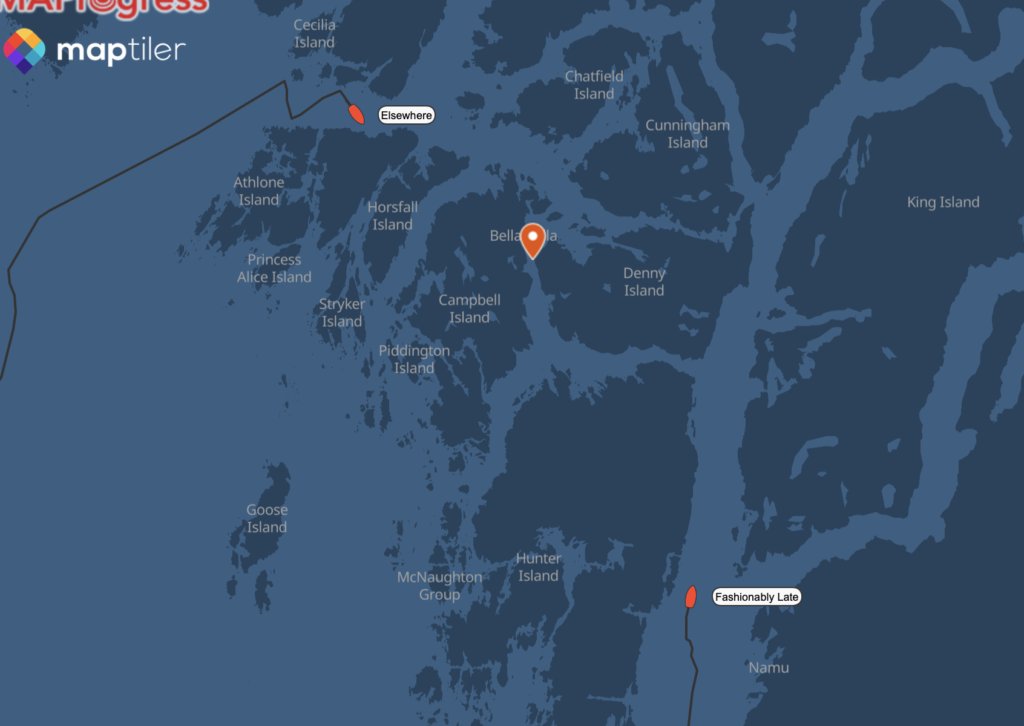
Meanwhile. Conditions in Queen Charlotte and Johnstone Strait look good for some of the human powered boats to log some miles today.
Resiliency is the name of the R2AK game…with some logs thrown in for good measure.
I have to start this report off with some huge props for the teams rowing, paddling and pedaling their way up the last sections of the Strait of Georgia and into Johnstone Strait. While it’s fun to follow the boats in the front of the pack, it’s sometimes more rewarding to see the stories that are unfolding mid-fleet and aft. Teams like Sockeye Voyages, Perseverance, Let’s Row Maybe?, Don’t Tell Mom, Bangarang and more are having a go of it and the R2AK media teams are capturing some great footage of all of them. (Check it out on Facebook: @RacetoAlaska and Instagram: @racetoalaska.)
In the official R2AK program, I wrote an analysis about how I thought the inside versus outside would play out, and it’s shaping up to be similar to what I imagined. Especially for the the Team Pure & Wild who, after a long beat to and around Cape Scott, finally was able to crack off onto a reach and head for Bella Bella. As I type this they’re only 13 miles from the checkpoint with a comfortable lead.
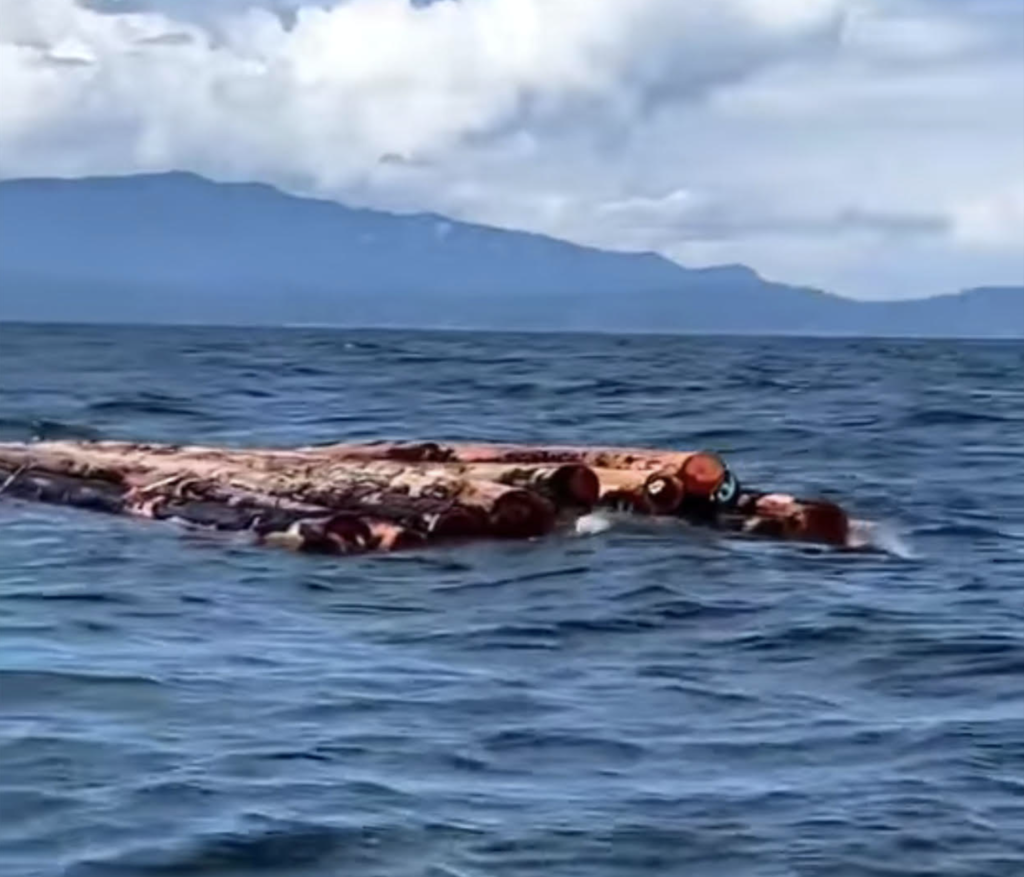
Although, is there any such thing as a comfortable lead in R2AK? Especially this year with all the logs rolling around in the waters of British Columbia and the carnage they have caused. Here’s what Race HQ has to say about that:
If BC’s timber industry cheerleaders are to be believed, British Columbia accounts for roughly 40% of Canada’s softwood lumber production. If racers, media boats, and the coastal BC community of pro mariners are to be believed, roughly 40% of that annual production is floating mid-race. Unless you can see it, it’s hard to imagine, and even if you’ve been up the inside before, it’s hard to wrap your head around just how much driftwood is in the water right effing now. This spring’s record high tides coupled with the highest rainfall in a metric decade flooding coastal rivers mean most of us haven’t seen this many logs in the water since the beginning of the Obama administration.
For all of you wondering why in the everloving Race to Alaska we’re talking about floating wood when there are teams racing to Alaska, you clearly haven’t been paying attention to the last 36-ish hours when at least three teams met enough driftwood, at enough speed, that it ended their race. Not just teams full of randos, but some of our fastest and favorites: Teams Pestou, Pturbodactyl, and Malolo.
Pout.
In past years, there has been a cavalier and chagrined punchline of pride between racers; the set up is some version of this:
Q: Isn’t there a lot of driftwood out there? How do you avoid it at night?
A: The logs just seem to go away at night.While that arrogant bit of self-denial might have been true for the cocky/lucky in years past, what’s proving thematically true in 2022 is that like humans, Gremlins, and cockroaches, driftwood now seems to multiply after the sun goes down and seems to get multiply-er the further north teams go… Keep reading
If this was called the ‘Race to Campbell River’, we’d have a tight one on our hands…alas, it’s not.
As of Saturday morning, inside teams are stacking up near Cape Mudge and Campbell River as adverse current keeps them from making significant progress. Once it switches around 9 a.m., though, it’s going to be a GREEN LIGHT for everyone to race toward Seymour Narrows. The problem is that, besides the current, right now there isn’t a whole lot of pressure predicted, so we’ll see…
Speaking of pressure, the teams on the outside are beating into the continued northwesterly wind. Team Pure & Wild is aiming for the Brooks Peninsula and once they get to Cape Scott they’re going to be in for a fast close reach towards the one and only checkpoint on the course at Bella Bella. Yes, things are progressing slowly, but this is shaping up to be a good one, folks!
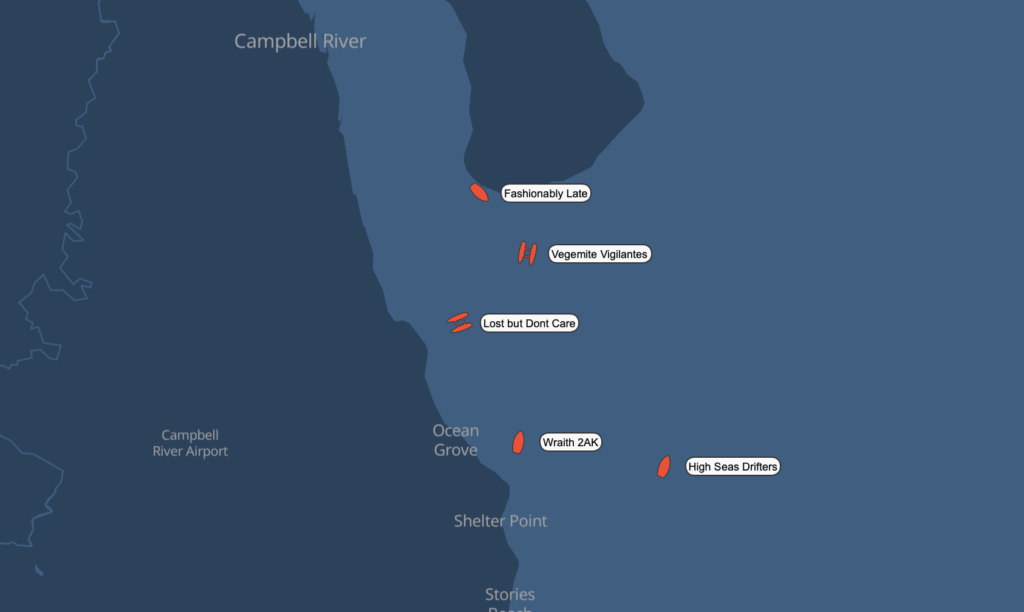
Strait of Georgia Delivering Northwesterly Winds.
After a lack of wind on the race course yesterday, a northwesterly breeze has settled over the Strait of Georgia today and the teams are battling. Two teams, Pestou and Pturbodactyl, have unfortunately had to throw in the towel with boat issue too difficult to overcome and continue safely.
LEG 2 is underway with light winds and logs…
When teams headed out of Victoria Harbour on Thursday they were met with predictably light winds. Reminiscent of the 2018 version of the race, the rowers jumped out to a commanding lead before the sailors finally found enough breeze to catch up. Teams Pure & Wild, Elsewhere and Kootenay Pedalwheelers headed out the Strait of Juan de Fuca while the rest went inside up through the Gulf Islands.
Ask of 6:30 am Friday, Team Malolo is leading the pack on the inside and Team Pure & Wild is leading on the outside. It’s going to be interesting to see how this plays out over the next few days, as it looks as thought the outside boats are going to step into more breeze…albeit from the northwest. We shall see!
Team Fashionably Late’s Mark Aberle checked in at 1:30 a.m. with this tidbit of info:
We hit a 12-foot thoroughly waterlogged log in Trincomali Channel. The log is now adorned with about $5 worth of blue bottom paint. Ahh, things that go bump in the night.
AND THEY’RE OFF!
Leg 2 of the Race to Alaska is underway from Victoria heading north for Ketchikan. It looks like three teams are going to tackle the outside — Pure & Wild, Elsewhere and Kootenay Pedalwheelers.
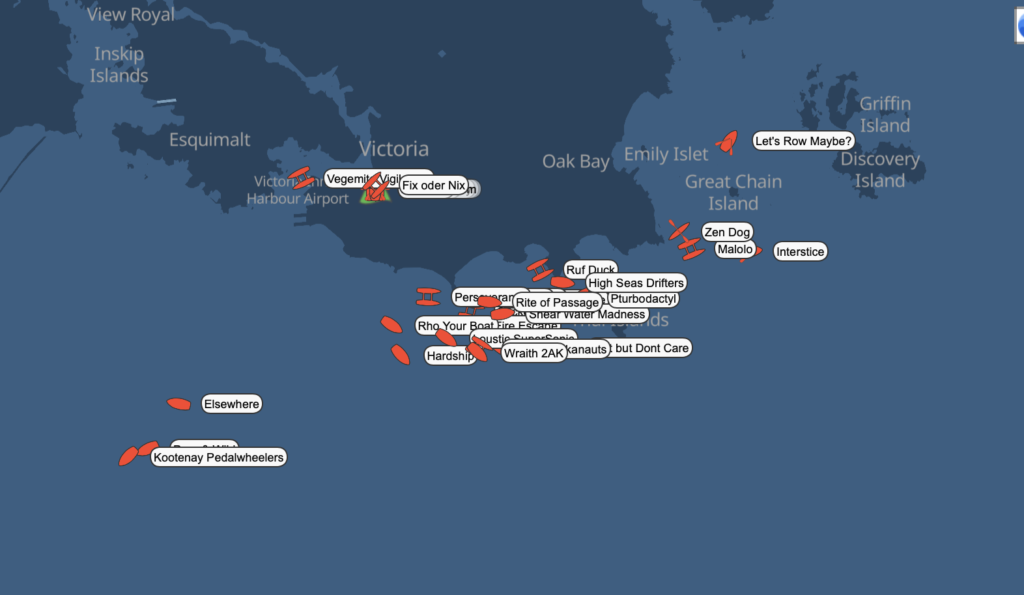
Stage 1, Day 2: Brunch fatigue, learning curves, and the citizens of Dungeness Spit
If your day was anything like ours, the second day of the R2AK 2022 started with a 5 am call with the Coast Guard just to make sure things hadn’t gotten worse. TL;DR: They hadn’t.
Talk to the (wo)Man, then peel back the eyelids with cup after cup after cup after cup after cup of as-strong-as-it-can-be/can-it-
Regardless of the coffee-stained pupils, when day dawned on Day Two of R2AK, our bleary-eyed snooze bar went from “Where are they and what do they think they are doing?” to “What are they doing in Victoria?” to “What are they doing on that beach?” to “How much brunch can they possibly have?” Depending on where they were, race teams’ realities seemed vastly different.
In case your internet is oddly relegated to this specific part of our website, what you don’t know until now is that after the epic wind and rescue fest of Day One, weather and waves split R2AK’s class of 2022 into roughly three groups: the teams that made it to Victoria, the teams that went home, and the teams in the balance… Keep reading…
After waiting for weather to calm in the Strait, teams were up early this morning and are underway for Victoria. They’ll be arriving at the “Proving Ground” finish throughout the day so follow the tracker HERE.
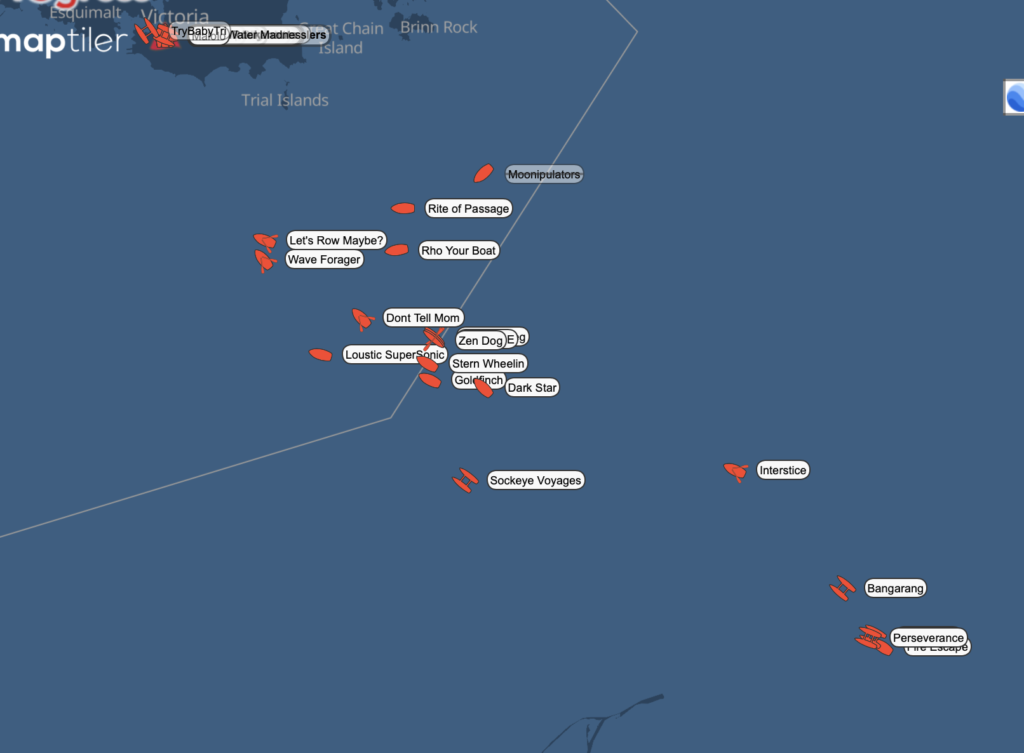
Stage 1, Day 1: The fast, the smart, and the broken
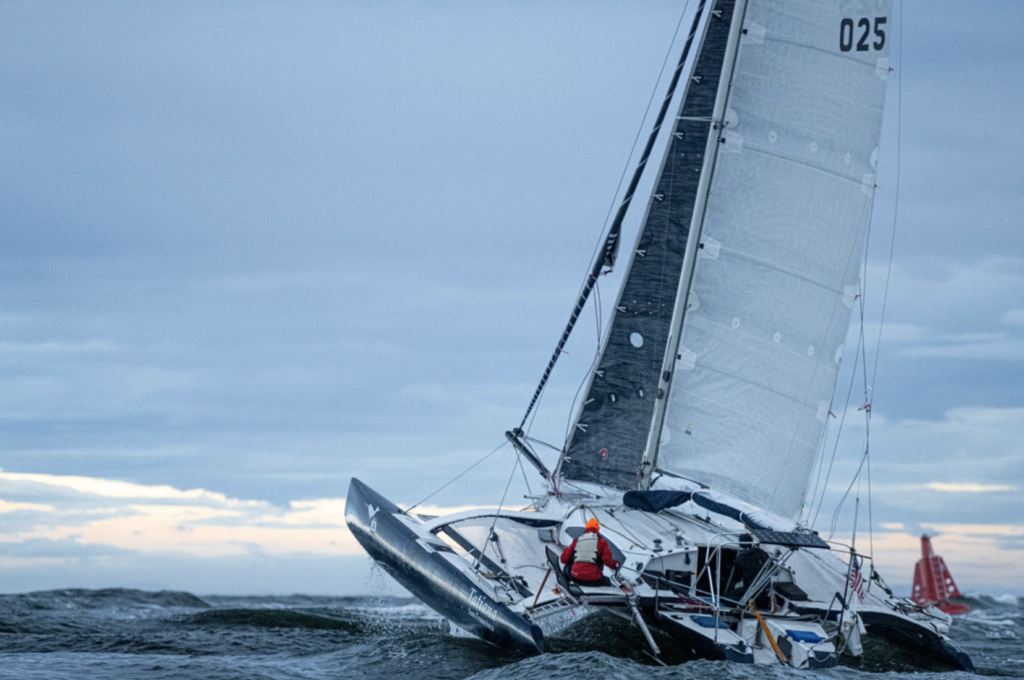
From R2AK HQ:
First, most important: everyone is ok. Us, you, 100% of this year’s racers, and the brave men and women of the US Coast Guard and R2AK support vessels that affected four rescues in the Race’s first four hours. Everyone is ok.
Bruised egos, dashed dreams, but body and souls intact. Breathe in, exhale slowly. Everyone is ok.
Level set/spoiler complete, the first 24 hours of this Race to Alaska started 12 hours before the starting gun. Yes, people showed up in the hundreds to cheer the teams across the starting line to the rousing chorus of the Ukrainian National Anthem. It was calm, community-spirited, and topically resonant. It felt great to be rousing again after almost three years of paranoid shrinking.
But before that, while the party still raged and free R2AK tattoos were still being needled into forearms, Race HQ extended the time window for racers to get to Victoria by a full 24 hours. Don’t be dumb, get there by Wednesday night, we told them. Why? The triple threat of wind, tide, and the knee knocker that is the Strait of Juan de Fuca.
If R2AK is a hero’s journey, Stage One is the impartial arch villain. Voldemort, the eye of Sauron, one Darth or another; from the 40-ish rough water miles between the Port Townsend starting line and the welcome embrace of Victoria’s Inner-est harbor, on a good day the Strait of Juan de Fuca is a crossing that is unnerving at best for any vessel designated smaller than “ship.” 20 miles from shore is discomforting to most, but especially given the standard shitty weather and sea states that are part, parcel, and legend and normal to this particular stretch. Yesterday the Strait lived up to at least 100% of its reputation.
It.
Was.
Brutal.
Team Fashionably Late had a wet ride en route to an 8th places finish and their spirits are high. Team member Mark Aberle checks in with this update: 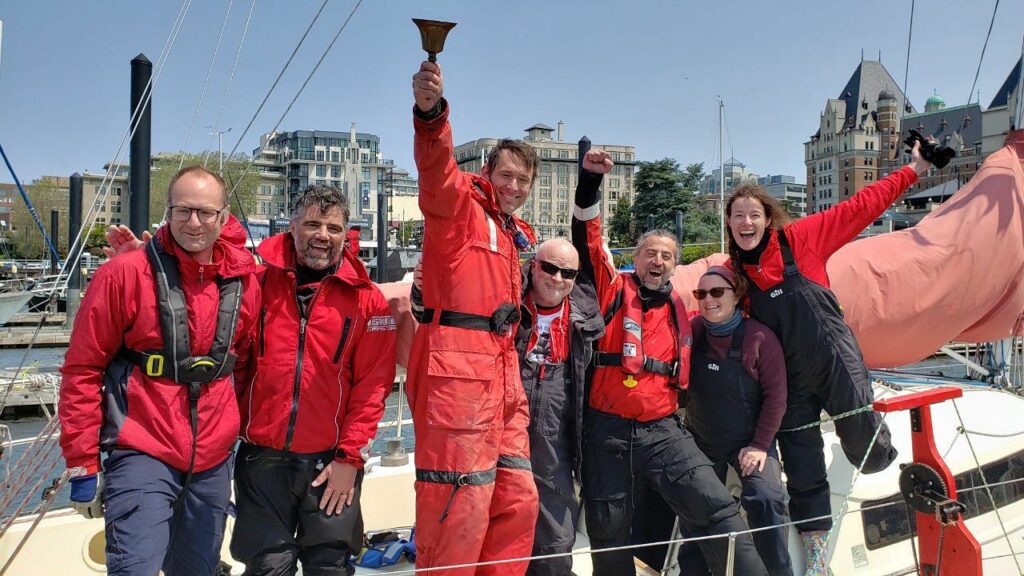
Team Fashionably Late, 8th into Victoria on the first leg, 12:16 p.m.
We were sailing at the upper end of the limits for the boat — a Dash 34. It could have taken more, but then tactics would have switched from driving towards a destination to more of a heaving-to approach and staying safe with the destination being secondary. We had three reefs in the main and the #3 jib. We did have a blade but did not use it. There was lots of motion and spray but the boat was under control 100% of the time. At one point, the wind strengthened and we thought about options to take cover, but we were sailing well and under control, so we pressed on. If it had gotten worse I suspect we would have taken refuge on the American side. All and all it was a physically taxing day… but a good day. Our crew agreed that, if attitude is the difference between an ordeal and an adventure, Team Fashionably Late has attitude.
After capsizings and a distmasting, we’re glad everyone is ok. Also, congrats to those who made it across safely. Here’s an update from Race HQ:
Rough conditions gave the Race to Alaska (R2AK) a hair-raising start, with 7 boats out of the race by 1 p.m. Pacific Time, despite a first-ever extension. Rough conditions across the Strait of Juan de Fuca led race organizers to extend the deadline for the Victoria, BC, Canada leg of the race by 24 hours, to give racers a total of 60 hours, so they could make prudent decisions based on conditions.

Despite the extended deadline, some boats attempted the crossing. While a number were successful, others were not. Teams requiring rescue assistance and returning to shore included:
- Razzle Dazzle, an Angus Row Cruiser, from Savannah, GA, USA (assisted by R2AK safety vessel)
- B Team, a Weta Trimaran, from Forestville, CA, USA (assisted by USCG)
- Runaway Redux, a C-Lark, from Palm Bay, Florida, USA (assisted by USCG)
- Narwhal, a Farrier 32 trimaran, from Seattle, WA, USA (assisted by R2AK safety vessel)
Four individuals were rescued from the water, in total. All individuals are safe and accounted for.
Team Pure and Wild, in a Riptide 44 Monohull, from Seattle, WA, USA was the first to reach Victoria. Six boats reached Victoria before 11:30 a.m. Pacific Time. 39 boats remain in the race, 7 have dropped out.
“R2AK was created to spread excitement about the magic of on-water adventures that are human-powered and sail-driven and to remind us all that big adventure can be obtainable on virtually any budget,” said Jake Beattie, Executive Director of the Northwest Maritime Center and co-creator of R2AK. “R2AK was created to reduce the constructs of an epic adventure to a bare minimum, trusting in the self-reliance and seamanship of our participants. The spirit of this race lives in the camaraderie of the racers and the unwavering impartiality of the elements.”
The R2AK Leg 1, from Port Townsend to Victoria, BC, was designed as the “Proving Ground,” close to civilization and within reach of a support system comprised of R2AK designated support vessels, the United States Coast Guard, and Joint Rescue Forces Canada.
The Race to Alaska is in its sixth year. The Northwest Maritime Center, the parent non profit of Race to Alaska, strives to ensure the highest possible standard of safety for all of its programs and events. To that end, safety measures are in place, including a team vetting process, GPS monitoring, required onboard safety equipment, and partnerships with emergency response agencies in the race course area. Race organizers have long worked closely with the US Coast Guard and Joint Rescue Forces Canada in the creation of each safety management plan and both agencies are invited annually to address racers at skipper’s meetings in Port Townsend and Victoria, BC.
Follow the race at R2AK.com
Facebook: @RacetoAlaska
Instagram: @racetoalaska
#BreakingNews #Update: (1/2) Hoist cam footage from the rescue of 2 individuals who entered the water after their sailing vessel capsized. This is from the Port Angeles based #USCG helicopter crew. @KIRO7Seattle @komonews @KING5Seattle @fox13seattle @PenDailyNews @KIRONewsradio pic.twitter.com/9gDeA2eq6t
— USCGPacificNorthwest (@USCGPacificNW) June 13, 2022
R2AK Begins!
Race to Alaska first leg first finishers are Team Pure and Wild coming into Victoria at 9:38 a.m. Congrats!
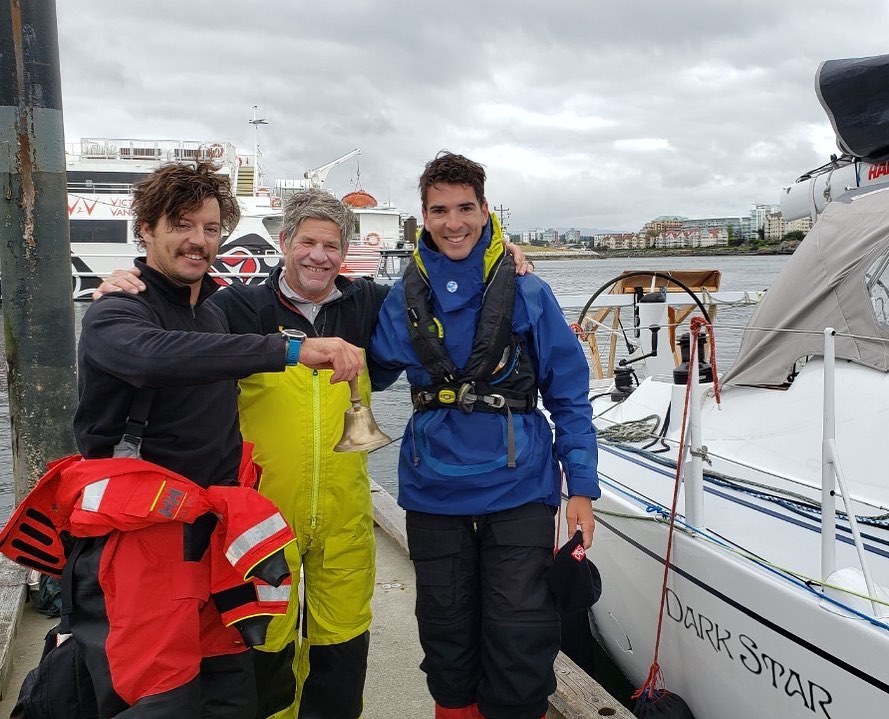
There’s also been some carnage on the course due to the predictably rough weather. Razzle Dazzle, B Team, and Runaway Redux capsized, all are safe. Narwhal dismasted and is safely back in Port Townsend, spirits are up.

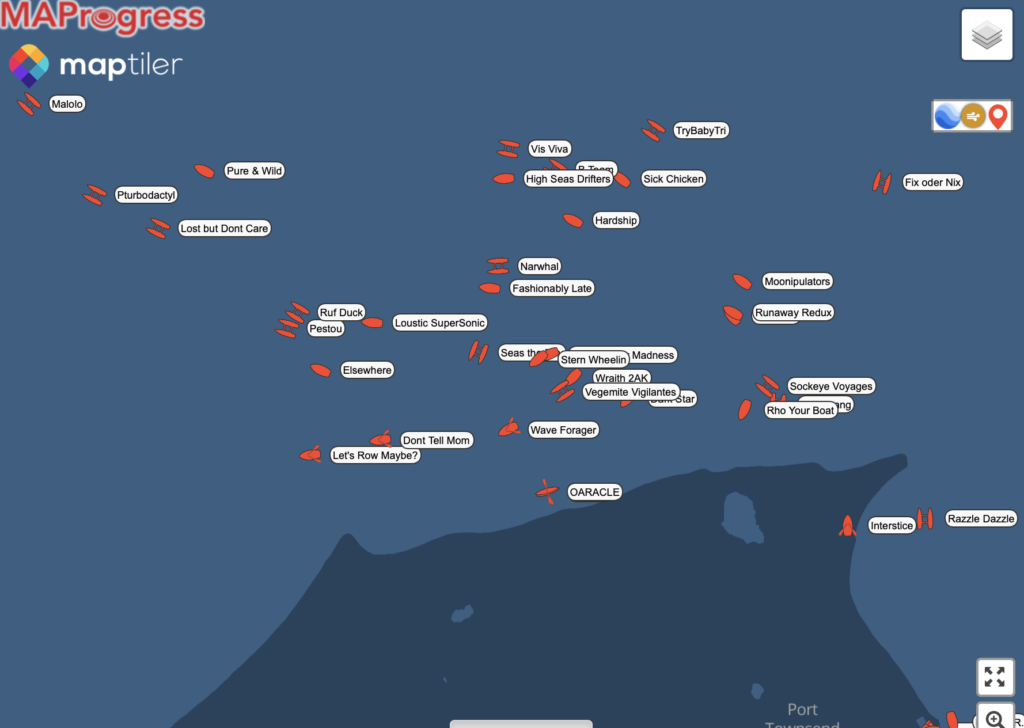 Update: With a weather forecast between seasick and dangerous for the next two days, R2AK High Command is extending the proving ground by 24 hours.
Update: With a weather forecast between seasick and dangerous for the next two days, R2AK High Command is extending the proving ground by 24 hours.
FOLLOW THE RACE TRACKER HERE
Here’s the SEVENTY48 report from Race HQ:
In 2021, Puget Sound was vindictive—less than half of the teams rang the finish bell—enough so, that we were flummoxed at the record number of teams enlisting for 2022, until we saw names, like Paddle On…Paddle On, Ted, Bad Rabbit, and Get Kraken; all back for another try. We knew a grudge match was brewing. Puget Sound clearly had been doing burpees for a year and was ready. More like a race through a water park, rain drove through the Gore-tex layers and even the start line held sodden eagerness in every eye. We stood on the dock yearning to utter the now-familiar benediction. Namaste racers. But it was not time for that. It was time to Namasgo. And Namasgo quickly.
89 teams crossed the finish line in Port Townsend with Team Imua taking line honors and setting a new SEVENTY48 record of 9h 35m. Team Wave Forager set the solo record of 9h 39m, and Teams like Get Kraken avenged their 2021 losses—a favorite line uttered by a team was, “I gotta stop, so my daughter will still want to hang out with me in the future.”
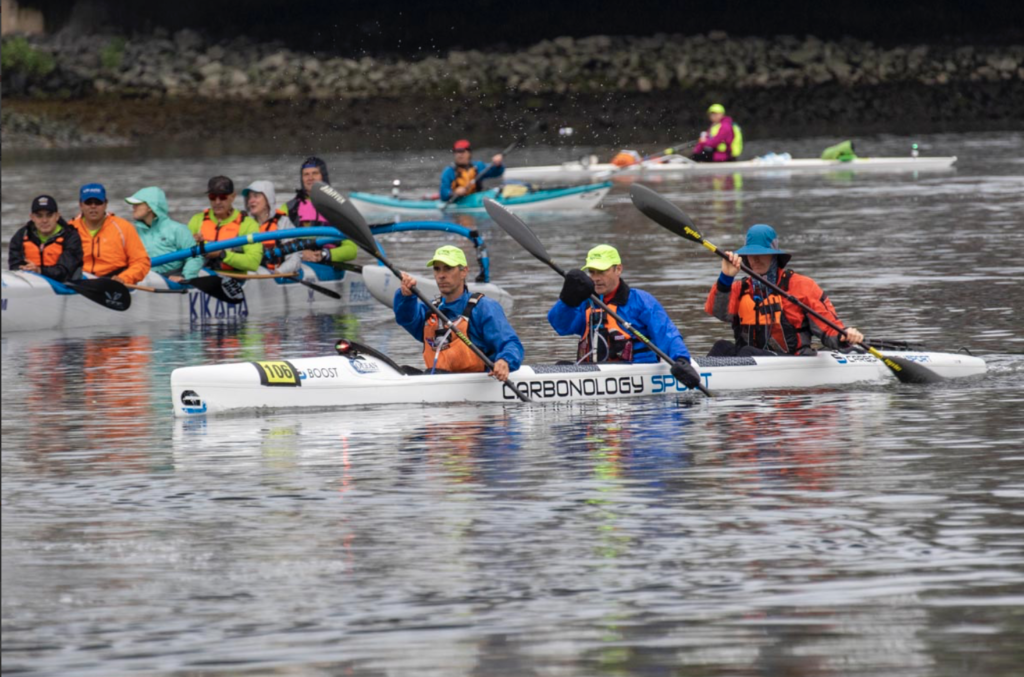
Every team’s worst moment is different and personal, but all involve one of the universal three: broken gear, broken body, or broken spirit (preferably not more than one at a time). The inverse is avoiding those three. However, what makes success will always be philosophically and/or drunkenly debated. Second-guessing will be rampant because we are human, loving to nag on ourselves and others. The only unifying point of all the seesaw of emotion and vociferous debate is this; 116 teams decided to line up on June 10th and put their best and worst to the test. Without that kind of risk—the kind that leaves you raw and vulnerable, scared and hopeful, daring and adventurous—all our lives would be dimmer sadder copies of ourselves. And we’d have nothing to talk about today. Huzzah to the racers of SEVENTY48. We’ll always want you to stay, but will always ask you to go.
Editor’s Note: Feature image courtesy of Dean Burke, all other images courtesy of the Northwest Maritime Center.
Andy Cross
Andy Cross is the editor of 48° North. After years cruising the Pacific Northwest and Alaska with his family aboard their Grand Soleil 39, Yahtzee, they sailed south and are currently in the Caribbean Sea. You can follow their adventures at SailingYahtzee.com.

